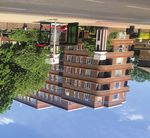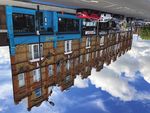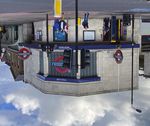Balham Area Strategy WANDSWORTH - Wandsworth Council
←
→
Page content transcription
If your browser does not render page correctly, please read the page content below
WANDSWORTH
D R A F T L O C A L P L A N
Balham Area Strategy
Wandsworth Council are in the process of
completely updating the borough’s Local Plan.
The Plan sets out a strategic vision and
objectives to guide the next 15 years of
development in the borough (2023-2038),
ensuring that growth and renewal happens in a
sustainable and co-ordinated way.
The new Local Plan will shape and guide decisions on the
location, amount and type of development the borough
requires to meet local needs. This includes buildings and how
they’re used, as well as supporting infrastructure and
accessibility. The Local Plan is the most important document
used to determine planning applications.
Area Strategies -
a place-based approach
Wandsworth’s draft new Local Plan places a greater
emphasis on how places are designed. Area strategies
have been developed to guide the growth of different
parts of the borough in a sensitive and tailored way. Each
area strategy is based on an integrated approach which
combines three themes:
• People First: Prioritising people to create more
sustainable, sociable and healthier communities that
maximise wellbeing and quality of life. A people first
approach allows meaningful choices in how people
travel, the housing they can access, the way they work, Have your say on the development of the
for play and across all aspects of day-to-day life. borough up to the year 2038 - take part in the
• Placemaking: Recognises that buildings, roads, parks and public consultation to shape Wandsworth’s
spaces all blend to create something called ‘place’. This
must be managed to mitigate climate change, support
draft Local Plan until 1 March 2021.
nature, value heritage, manage traffic and secure
resilience. It is through the combination of management For details please visit:
and design that place identity is established. wandsworth.gov.uk/localplanreview
• Smart Growth: Concentrates on managing development
to deliver economic, social and environmental
outcomes. It supports a vibrant local economy that
creates jobs and opportunity, and emphasises the
provision of inclusive, affordable housing. Smart Growth
promotes developments that are fit for purpose,
responsive to the local context, and which recognise that
mixed use supports sustainable places.An Area Strategy for BalhamArea Performance
Area Performance
Area performance considers the 14 elements that make up
the People First, Placemaking and Smart Growth criteria to
&
provide a simple framework to help guide placemaking
objectives as set out in the Area Strategies of the Plan. %
There’s no right outcome for area performance as each place $
is unique. However, it allows you to think about the 14 !
elements of a place and the complex issues within places, #
allowing local people, decision-makers and others a
"
common platform to assess needs and potential. The 14
elements are highlighted in the diagram and explained & % $ ! # "
further in the draft Local Plan.
"
Balham is a cohesive community that supports a People First #
approach as it performs well as a 15-minute neighbourhood !
that helps lifestyle choice for the community. This can be $
reinforced by promoting active travel, such as walking and %
cycling. Placemaking outcomes support public transport &
connectivity and good open space provision which is attractive
to all. Balham has a good identity and form. Development has
delivered on Smart Growth with local employment, housing
range and diversity of use performing reasonably.
To find out more about the Balham Area Strategy, the place See page 166 of the draft Local Plan.
performance criteria and definitions please see section 10 of
the draft Local Plan.
Character and Opportunity
Balham is characterised by Victorian and Edwardian terraces
that contribute positively to the street scene, with a sense of
diversity, variety and colour. There is a feel of individuality to
buildings (e.g. shop fronts along Hildreth Street), yet these
create a coherent overall unity.
Balham developed following the opening of the railway in
1856. The station stimulated development of the fields lying
behind the early ribbon development along Balham Hill and
Balham High Road, creating new residential estates. This
development and the commercial growth of the centre was
further accentuated by the introduction of a tram in 1903, and
then the extension of the Underground in 1926.
Today, Balham is an established and accessible urban centre
that forms a local destination for eating, drinking and
shopping. The town centre is focused on four roads: Balham
Station Road, Balham High Road, Bedford Hill and the
pedestrianised Hildreth Street, which create a triangular
shopping circuit with a Sainsbury’s supermarket at its heart
and Waitrose close by. Balham benefits greatly from Hildreth
Street, which hosts a popular street market and has an
emerging café culture. The centre is well provided for
community facilities.There is a high incidence of post-war infill development,
some of which are unsympathetic. There is also evidence of
gradual deterioration of the built form towards Tooting Bec
underground station. The area also suffers from the lack of
street trees.
Balham is greatly enhanced by positive landmarks on corner
plots, including the Bedford and Devonshire pubs. Historic
interest is also provided by the Du Cane Court, a distinctive 8
storey 1930s residential block and churches: St Mary's Church
and Polish Church of Christ the King.
The presence of rail and underground stations enable
excellent access to public transport in Balham. Although
Balham benefits from excellent public transport accessibility,
the area is dominated by car parks. These features negatively
affect the street scene and attract a lot of cars to the main
road. Balham High Road is busy and generally difficult to
cross. The area is served by Cycle Superhighway 7, however
there are issues with the quality of the cycle lane, and there is
also insufficient provision of local cycle lanes.
Vision
• Restore the town centre's character by supporting
improvements to existing frontages and creating well-
located new homes and offices.
• Provide an inclusive and connected public realm/open
space and encourage urban greening to create a
pleasant and people-focused urban environment.
• Support measures to reduce the dominance of cars and
improve opportunities for active travel.
• Support development at key gateways to the centre that
create a stronger definition.
• Make efficient use of the allocated site at the eastern
end of the town centre.Balham Area Priorities
People First Placemaking Smart Growth
• Bedford Hill Place and areas adjacent • Promote a stronger definition to the • To ensure that future growth enhances
to Balham Library present desirable northern, southern and eastern ends the unique townscape qualities of the
locations for the expansion of of the town centre with development area, the strategy aims to provide at
Balham’s cultural offer. proposals to the eastern end of the least 130 homes between 2023 and
town centre aiming to reduce the 2038, (in addition to those which will
• Development should promote more
dominance of existing surface car already be completed prior to 2023),
space for pedestrians, especially on
parking. Development proposals to and to promote additional growth
routes to Balham Station and by
the southern end of the town centre which enhances existing character.
providing better waiting areas for bus
should aim to distinguishing between
passengers on Balham High Road. • Retain a strong retail core which is
the identities of Tooting Bec and
focused on the area of Balham High
• Measures to widen pavements along Balham.
Road to the north of the station.
Balham High Road will be supported.
• Opportunities to repair, improve and
These should integrate high quality • Proposals for cafes, restaurants and
unify existing frontages are
public realm and street trees in order ‘twilight’ evening uses will be
encouraged, particularly to the south
to improve the pedestrian experience encouraged; particularly on the
of Balham High Road. Where historic
and reduce the perceived dominance pedestrianised Hildreth Street.
shopfronts and features are present,
of vehicle traffic.
these must be retained. • The protection of existing and
• New development will be expected provision of affordable new offices, as
• Appropriate development, particularly
to provide loading and servicing off part of the mixed use redevelopment
for office and residential use, that
street where possible, and on side of allocated sites is expected.
restores the consistent building line
roads where not, in order to reduce
and height along Balham High Road
congestion.
will be supported.
• Improvements to Cycle
• Where appropriate, development
Superhighway 7 on A24 corridor and
proposals should make provision for
other local cycle lanes will be
new street trees.
supported.
• Proposals on Hildreth Street should
• Proposals should deliver and/or fund
contribute to the pedestrian
cycle parking provision where there is
environment and the public realm to
a deficiency.
support the operation of a street
market.
• Loss of open space will be resisted an
opportunities to create additional
open space and public realm
enhancements will be supported.Balham Area Strategy Map
d
hR
Hig
ham
Bal
Hi
ldr
et h
St
ree
t
Be
dfo
rd
Hil
l
Sainsbury’s
Balham
d
e sR
d ar i
un
Bo
1
Balham
Leisure Centre
2
Public realm and active travel Growth location Transport infrastructure
Suggested location for new public open space Site Allocation Boundary Balham Railway Station
Existing route 1 Sainsbury’s Car Park, Bedford Hill, SW12 (Ref: BA1)
Active travel enhancement 2 Balham Health Centre, 120 - 124 Bedford Hill, London,
SW12 (Ref: OUT1)
Suggested public realm improvement Background information
Cycle Superhighway Metropolitan Open Land
Main shopping area
Suggested building frontage Other open space
Hildreth Street (pedestrianised street with al fresco cafés,
Valued view and vista restaurant and independent shops) Balham Town CentreHow can you help?
The council is inviting comments from all kinds of local
stakeholders, residents, businesses, community and amenity
groups, landowners and developers.
As a local expert, we are particularly interested in hearing your
thoughts on the Area Strategy for Balham.
To participate, visit wandsworth.gov.uk/localplanreview
What happens next?
The council will review all of the feedback submitted as part of
the consultation, and this will help to inform a revised version
of the draft Local Plan (known as the ‘Publication’ version).
There will then be a further opportunity to provide comments
on that version of the Local Plan, which is expected to be held
in the autumn of 2021.
Timetable
1. Monday 1 March 2021 - Public Consultation on the
‘Pre-publication’ Draft Local Plan (the current version) ends.
2. Spring/Summer 2021 - The council analyse and consider
the responses from the consultation, which are used to
inform a revised ‘Publication’ Draft Local Plan.
3. Autumn 2021 - Further public consultation on the
‘Publication’ Draft Local Plan.
4. Spring 2022 - The Publication Draft Local Plan and
representations received in the consultation are submitted
to the Secretary of State, who appoints an independent
Planning Inspector to examine the Plan for ‘soundness’.
5. Summer / Autumn 2023 - If the Inspector is satisfied with
the new Local Plan, it is adopted by the council and comes
into force.
See the full plan and comment online:
wandsworth.gov.uk/localplanreview
Designed and produced by Wandsworth Design & Print. wdp@wandsworth.gov.uk EC.527 Balham (1.21)You can also read



























































